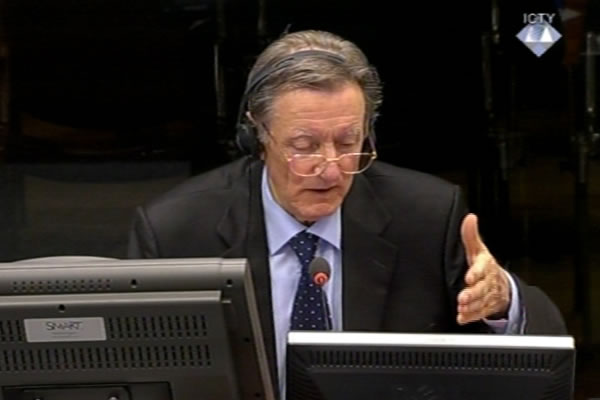Home
GENERAL PRAISES HIS CORPS
Former commander of the Sarajevo-Romanija Corps Dragomir Milosevic contends that his unit launched artillery attacks only on military targets and used snipers to respond to snipers operating from the city. According to Milosevic, his corps prevented crimes against non-Serb population around Sarajevo
 Dragomir Milosevic, defence witness of Radovan Karadzic
Dragomir Milosevic, defence witness of Radovan Karadzic In the cross-examination of former Sarajevo-Romanija Corps commander Dragomir Milosevic, the accused Radovan Karadzic dealt with a document the prosecution has used to prove that the Bosnian Serb army launched deliberated and indiscriminate artillery attacks on civilian areas of Sarajevo. The document is General Milosevic’s order of 6 April 1995 to fire an air bomb on the Hrasnica settlement at a target ‘where the greatest casualties and physical damage would be inflicted’. The bomb was fired the next day from a make-shift launcher. It hit the center of Hrasnica, killing a woman and wounding three other civilians.
In an effort to justify the order, General Milosevic said today that the strongest brigade in the BH Army 1st Corps was stationed in Hrasnica. Milosevic added that he merely signed the order drafted by his artillery commander. Milosevic said he ‘didn’t find it necessary’ to change anything in the order. The author of the document explained to Milosevic that inflicting the ‘greatest casualties and physical damage’ meant that only military targets would be attacked.
The accused Karadzic then showed an UNPROFOR report of 7 April 1995, which states that the attack on a civilian house with a modified air bomb ‘was probably carried out in retaliation’ for the mortar fire from Hrasnica on the Serb positions. Milosevic contends that during his trial his defense hadn’t been aware of this document. The judgment sentencing Milosevic to 29 years mentioned the modified air bomb attack in Hrasnica as an example of artillery attacks on citizens of Sarajevo.
Apart from the artillery attacks on Sarajevo, the judgment in General Milosevic’s case and the indictment against Karadzic both refer to a number of sniper attacks on civilians in the city. Both Milosevic and Karadzic today tried to rule out any possibility that the Sarajevo-Romanija Corps may have deliberately attacked civilians with snipers. Karadzic showed a series of Bosnian Serb army documents which indicate that the BH Army had sniper rifles. The witness said that the soldiers from his corps used snipers only to respond to the attacks of the enemy from the city.
General Milosevic finds it ‘impossible’ that he or any of his subordinate commanders ordered the use of snipers against civilians. However, Milosevic allowed the possibility that in situations when his forces responded to fire from the city, some bullets may have ‘hit a tram’ in crossfire.
The witness claimed that his soldiers cared about the well-being of the civilians in the city and did everything to protect the Muslims who remained in parts of Sarajevo under the control of Serb forces during the war. ‘No non-Serb civilians were victims of detention, beating, torture or liquidation’ in the area of responsibility of the Sarajevo-Romanija Corps, Milosevic claimed.
Although in his defense case Karadzic has been trying to absolve Milosevic’s corps from the responsibility for the terror campaign against Sarajevo, today Karadzic, in a bid to keep all his bases covered, denied any links with the Corps, which was part of the army under Karadzic’s supreme command. When Karadzic asked Milosevic if the political leadership under Karadzic’s leadership had any influence on the combat operations of the corps, General Milosevic denied it and self-confidently emphasized that it wouldn’t have been ‘clever or rational’ to try to do it.
Karadzic has half an hour to complete General Milosevic’s examination-in-chief.
Linked Reports
- Case : Karadzic
- 2013-01-28 GENERAL MILOSEVIC: I WAS TOLD WE WEREN’T RESPONSIBLE FOR THE MARKALE 2 INCIDENT
- 2013-01-25 ORIC’S TESTIMONY COULD ‘SERIOUSLY DAMAGE’ KARADZIC
- 2013-01-24 SREBRENICA: ORGANIZED BY MUSLIMS, IMPLEMENTED BY SERBS
- 2013-01-31 “TYING FLAGS” AGAINST SERBS
- 2013-02-04 SARAJEVO WOULD HAVE BEEN ‘ASHES AND DUST’ HAD IT NOT BEEN FOR GENERAL MILOSEVIC
- 2013-02-05 GENERAL MILOSEVIC AND TRAMS IN SARAJEVO
